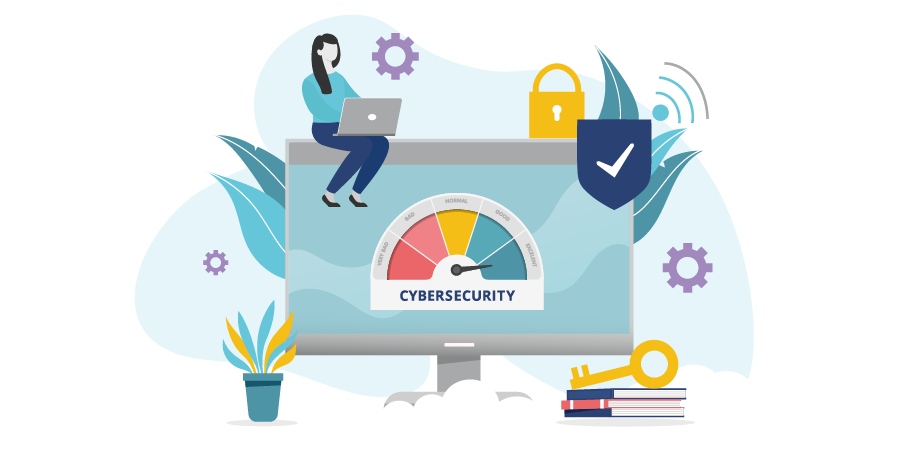Hacking the Hackers: Cyber Scanning 101
February 14, 2023

The cyber landscape is complex and ever-evolving—and hackers show no signs of slowing down. As new technologies emerge, criminals are constantly adapting their techniques to infiltrate networks and exploit vulnerabilities. In addition to threats like social engineering and ransomware, companies must now combat emerging risks, like DDoS attacks, third-party compromise, quantum computing, and more.
But despite a growing awareness of online threats, many businesses still aren’t doing enough when it comes to security. Either they don’t have adequate safeguards, or they’re failing to patch or update them regularly, leaving the door wide open for cybercriminals, as well as lasting financial, legal, and reputational harm.

To keep up with an influx of increasingly sophisticated and disruptive attacks, it’s critical for all organizations to prioritize ongoing cybersecurity and routinely scan their networks, systems, and applications for gaps in protection. Keep reading to learn more about your risks and how cyber scanning can help you prevent a breach, minimize operational disruptions, and control costs long-term.
Disclaimer: Please note that the information provided herein offers guidelines only. It is not exhaustive and does not constitute legal or cybersecurity advice. For more guidance, please consult a lawyer, a licensed insurance representative, and/or a cybersecurity specialist.
1. Cyber Risk
THE RISK:
These days, it’s easier than ever for attackers to gather intel about their targets. Why? The information that could be used to compromise your security is widely available and often in plain sight. Hackers use a variety of off-the-shelf tools to scan systems for open ports, insecure connections, malicious code, outdated software, and other vulnerable endpoints. In no time at all, they can learn all about your technology stack—your server, the software it’s running, your devices, their configurations, active IP addresses, and more.
From there, threat actors can leverage this data to map your network, locate entry points, and launch attacks with precision and detail. Alternatively, since scanning can be automated, hackers of all backgrounds and skill levels can search for weak spots and sell their findings on the dark web for a quick payday.
RELATED: Why Experts are Calling Log4j the Worst Security Flaw of the Decade and Why You Should Care
THE SOLUTION:
You can beat hackers at their own game by periodically monitoring your networks and identifying potential risks before they become a problem. Then, you can plug holes and take steps to improve your digital hygiene, whether that’s by implementing stronger access controls, updating software, or ramping up awareness training, minimizing the likelihood of a breach.
For maximum protection, consider the Cyber Insurability Assessment, a comprehensive scanning service offered by our partner, ISA Cybersecurity, a leading Canadian cybersecurity firm. Once you sign up, you’ll receive a detailed monthly report that evaluates your internal and external systems and flags vulnerabilities in ten major categories: perimeter defences, application and endpoint security, DNS health, cubit score, patching cadence, IP reputation, hacker chatter, information leaks, and social engineering. Simply put, the Assessment will scan your entire attack surface and show you everything that might catch a cybercriminal’s eye.
In addition to technical security, the insights from the report will give you a more holistic view of your cyber ecosystem and help you determine the effectiveness of your risk management strategy. With concrete data points, you can adjust policies, make investments, or allocate funds towards areas with the greatest exposure.
RELATED: The Consequences of a Breach: Can your business survive a cyberattack?
2. Insurability
THE RISK:
In the event of a breach, a Cyber Insurance policy can help you offset your losses, restore your assets, and get your business back online. Unfortunately, it’s never been harder to qualify for coverage. After years of breaches, high claims payouts, and ransom demands, insurance companies are being more selective about what risks they’ll take on and mandating certain cybersecurity controls for all clients. Anyone that fails to meet these standards will only receive partial coverage or be denied coverage altogether.
While every insurer has different criteria, most are asking for the basics: multi-factor authentication (MFA), encryption of all data in-transit and at-rest, offline backups, and security awareness training for all employees, though these requirements are likely to get stricter as attacks mount. Additionally, most insurers are also using similar third-party tools to scan your servers, get a better sense of your security posture, and determine your insurability. And if the results are poor, they won’t give you the opportunity to fix the vulnerabilities before choosing not to insure you or cancelling your policy.
Without adequate security, you’ll be hard-pressed to find an insurance company willing to take you on. And without insurance, you’ll have to shoulder the breach costs out-of-pocket, leaving yourself exposed to hundreds of thousands in regulatory fines, legal fees, restoration, and other remediation expenses.
RELATED: Sink or Swim: How Businesses Can Survive the Cyber Tsunami
THE SOLUTION:
Whether you’re shopping around for your first Cyber Insurance policy, or renewing an existing one, the Cyber Insurability Assessment can boost your chances of obtaining coverage. Unlike most third-party scanning tools which only measure security, ISA’s report is specifically designed to evaluate your insurability. It won’t just show you what hackers see—it’ll show you exactly what insurers see and help you understand how you measure up against their requirements.
The report also outlines specific steps and strategic recommendations for improvement. This way, you can proactively resolve any issues that might disqualify your application before you even reach out to them. Plus, using a scanning service will also show insurance companies your dedication to data protection, putting you in the best position possible to secure coverage.
3. Insurance Costs
THE RISK:
If you don’t meet security requirements, insurance companies might also use scan results to quote you a higher price or raise your premium instead of denying coverage outright. In our experience, a bad scan can even result in an increase of 200-300% (at least $1000 or more) at renewal time.
But what if you patch the vulnerabilities found in the scan and then re-apply for coverage? Here’s why that won’t do you any good:
1. Operational Disruptions
Most businesses don’t begin the renewal process until a few weeks before their policy is set to expire. That means they’re already on a time crunch, especially if they have to meet clients’ contractual requirements for insurance. Unfortunately, security holes usually take at least a month to fix, which will create chaos for your IT team, who might already be backlogged from your day-to-day maintenance. Depending on the flaw, you might even have to outsource the fix, which could take longer and cost more. By that point, your existing policy might lapse, or you might miss your client’s deadline to obtain coverage.
2. Fixed Pricing
Whether or not you repair your security, insurance companies won’t offer to reprice your premium once the scan is complete; your insurance costs will be based on what they found in the report, not what you fixed. Unless you’re willing to forgo Cyber Insurance altogether, you’ll be stuck with a higher premium for an entire year until the next renewal cycle when they rescan your servers.
3. Limited Options
If your current provider won’t budge on price, you might consider switching insurance companies. But most businesses underestimate just how tough it is to find the right coverage. Depending on your size and operations, it could take weeks for you to find a new provider, apply for coverage, and work out pricing, during which time your policy could expire.
THE SOLUTION:
At a basic level, using a scanning service can help you control your insurance costs by reducing your overall cyber risk. The tighter your security, the less likely a breach is to occur, which will keep your premium low.
Additionally, the Cyber Insurability Report runs every month, which will allow you to monitor changes in your threat environment and uncover issues as they arise. Threats are also ranked by low, medium, and high severity so you can prioritize the areas of greatest impact to your insurance coverage for timely remediation. Instead of applying random patches, you can make informed decisions and take a more targeted approach to protect critical business systems.
While you can subscribe at any time, we generally recommend signing up at least 6 months before your current Cyber Insurance policy expires so you can manage your timelines and reduce the burden on your IT team. You might not be able to fix every issue in the report in advance, but you can still tackle a lot of the critical items and try to minimize premium increases. Plus, if you’re still looking to switch insurers later on, being in strong shape security-wise will ensure that you have sufficient time to get more competitive quotes.
RELATED: All About Cyber Insurance: What is it, What’s Covered, and Why Do You Need it?
4. Lost Revenue
THE RISK:
Given the rise in attacks, clients, partners, and other stakeholders might want guarantees that their data will be protected if there’s a breach. As a result, many are increasing their contractual requirements for cybersecurity and Cyber Insurance. These requirements can range anywhere from having basic safeguards, to carrying certain levels of coverage, to a combination of both. Some organizations might even ask for a certificate of insurance as proof before proceeding with the contract.
However, if a poor scan results in cancelled or reduced coverage, your contracts could be held up. And prospective clients or investors might not be willing to stick around while you shop around for another policy. That means you won’t just be losing time or momentum that could help you reach your goals; you’ll actively be losing financing or profits that will move your business forward. According to the 2022 CIRA Cybersecurity Survey, 17% of organizations reported loss of revenue following an attack. 19% reported reputational damage and 15% reported a loss of customers following an attack, a figure which doubled from pre-pandemic levels.
Even worse? If it takes anywhere from 30-90 days to address the issues found and your policy expires in the meantime, you’ll have a gap in coverage; your new policy won’t cover any breaches discovered before it became active. Here’s an example: say your Cyber Insurance expires January 1 and you get a new policy on March 1. On March 15, you discover a breach in your organization that occurred sometime in January. Because you didn’t have insurance during this time, your policy won’t cover the losses.
THE SOLUTION:
By staying on top of cybersecurity and insurability, you can smooth out any delays in the application or renewal process. You can meet, or even exceed, clients’ requirements and avoid any penalties or liabilities for non-compliance. And above all, you can show clients that you take their security seriously, build your credibility, and give them the confidence they need to do business with you.
Is it worth it?
We know, it seems like an unnecessary, extra cost to another security measure to your systems. But if you suffer a breach, the cost of recovering from an attack will be significantly higher. And keep in mind: it only takes one misconfiguration or missed patch to compromise your entire network. With the Cyber Insurability Assessment, you can keep up with evolving risks and requirements and ensure that a breach doesn’t jeopardize your business operations. To learn more about this service, click here.
Even if ISA’s report doesn’t seem like the right fit for you, we still encourage all organizations to consider cyber scanning. A strong cyber risk management strategy is all about being proactive and regular scans will help you stay ahead of any potential threats or disruptions and ward off attacks. And while no prevention is 100% foolproof, you can harden your defenses enough that hackers move onto an easier target altogether.
What else can you do?
For more guidance on cyber risk management, connect with PROLINK. With over 40 years of experience and a specialized knowledge of cyber markets, PROLINK is ahead of industry trends. We help you understand, manage, and offload your risks and become resilient in the face of attack. Our dedicated team of advisors will:
- Identify cyber perils, attack scenarios, and any potential losses based on your business operations and unique needs;
- Share what steps others in your industry are taking and advise you accordingly;
- Conduct a robust assessment of your existing insurance policies to detect any coverage gaps;
- Align you with specialized Cyber Insurance and risk management solutions, tailor-made for your strategic objectives and budget.
To learn about your exposures—and how you can protect yourself—visit our Cyber Security & Privacy Breach Toolkit and connect with PROLINK today!
PROLINK’s blog posts are general in nature. They do not take into account your personal objectives or financial situation and are not a substitute for professional advice. The specific terms of your policy will always apply. We bear no responsibility for the accuracy, legality, or timeliness of any external content.




